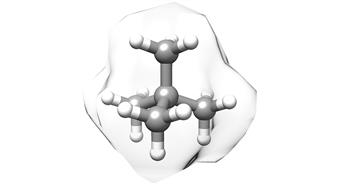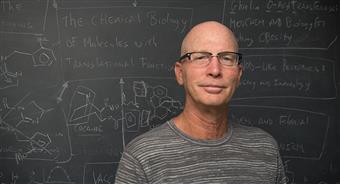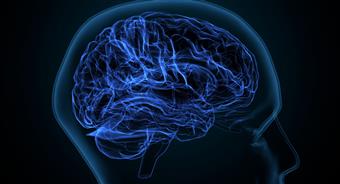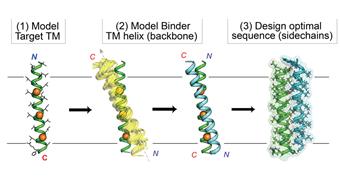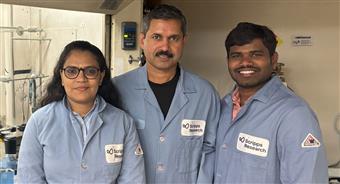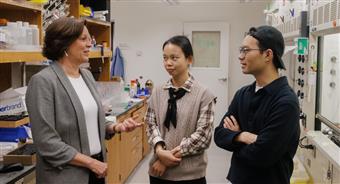
New advance in modeling the chemistry of the origin of life Study demonstrates a closely related set of chemical reactions that could have supported the development of early life forms.
LA JOLLA, CA One of the greatest, most enduring scientific mysteries concerns the origin of life on Earth. How could this complex system of self-replicating molecules, each component of which is heavily dependent on the others, have developed from the chemistry available on our then-lifeless planet roughly four billion years ago? Origin of Life chemists at Scripps Research have now made a significant advance in answering this fundamental question.
In a study reported in the chemistry journal Angewandte Chemie, the scientists demonstrated a set of related reactions that could have enabled the transition, on the primordial Earth, from pre-life chemistry to the biochemistry of the first simple life forms. The reactions yield molecular building blocks that can be stitched into DNA-like strands, either with the help of reaction-speeding organic catalyst molecules that were plausibly present before life arose, or with more efficient enzyme catalysts that early life forms would have used.
This study is a proof of principle that the transition from an abiotic' world without enzymes to an early biological world that has enzymes could have involved the same chemistry throughout, says study senior author Ramanarayanan Krishnamurthy, PhD, associate professor of chemistry at Scripps Research.
Every modern DNA-based organism makes its DNA from building blocks called nucleotides using highly evolved, highly efficient polymerase enzymes. These enzymes are themselves encoded in the organism's DNA; they are, in other words, part of the world of biology, and were not present on the Earth before life arose. One of the big challenges, then, for origin of life researchers, is to explain how DNA, or its molecular cousin RNA, could have emerged from a world without enzymes.
In recent studies, Krishnamurthy and his colleagues have shown how an organic compound called diamidophosphate (DAP), with the help of another compound called imidazole which acts as a non-enzyme catalyst could have modified simple molecules called nucleosides into nucleotide building blocks closely resembling those of modern RNA and DNA. DAP, the imidazole and the nucleosides were all plausibly present on the early Earth before life arose. The researchers also have shown that such reactions could even have knitted the nucleotides into short, mini-DNA-like chains called oligonucleotides, which conceivably could have been the first self-replicators.
In the new study, the researchers showed that a similar DAP-mediated reaction, now using a chemical cousin of imidazole called aminoimidazole as a catalyst, can transform nucleosides into primitive nucleotides and oligonucleotides, but at the same time can also make nucleotide building blocks that are much more like those in contemporary biology, and are capable of being stitched into long strands by enzymes.
The work suggests that the same basic soup of chemical reactants could have yielded short oligonucleotides in a pre-enzyme world, and much longer, more DNA-like oligonucleotides in a living world that had begun to make enzymes.
That life-promoting chemistry could thus have driven the possibly eons-long transition from a lifeless, enzyme-less Earth to an Earth with a primitive biology including the first enzymes, Krishnamurthy says.
A key event that is presumed to have happened in this transition, he adds, is the appearance in the early, enzyme-free reactions of a short, primitive oligonucleotide that either on its own or through its encoding of a primitive protein had the enzyme-like ability to catalyze its own production.
Then you would have a system in which the catalyst is able to use nucleosides in the environment to make more copies of itself and with that onset of simple self-replication, the ingredients of biology would start to fall into place, Krishnamurthy says.
Krishnamurthy and his colleagues now are working with the new reactions to see if they can produce such a self-catalyzing molecule, which would represent one of the last missing pieces of the Origin of Life puzzle.
Apart from its basic science significance, the research may bear fruit commercially, since it involves new and potentially more efficient and robust ways of synthesizing DNA and RNA techniques that could have widespread applications in the worlds of biology and biotechnology.
Concurrent Prebiotic Formation of Nucleoside-Amidophosphates and Nucleoside-Triphosphates Potentiates Transition from Abiotic to Biotic Polymerization, was co-authored by Huacan Lin, Eddy Jim nez, and Ramanarayanan Krishnamurthy of Scripps Research; and by Joshua Arriola and Ulrich M ller of the University of California San Diego.
The research was supported by a joint National Science Foundation and NASA program (CHE-150421), the Simons Foundation (327124FY19), and a grant from NASA (80NSSC19K0467).
Chemistry Krishnamurthy, Ramanarayanan
More from Scripps
12/04/2024
Scripps Research chemists devise easier new method for making a common type of building block for drugs Scientists transform simple linear amines into saturated...
06/04/2024
A simple, inexpensive way to make carbon atoms bind together A Scripps Research team uncovers a cost-effective method for producing quaternary carbon molecules,...
04/04/2024
Developing a vaccine for the zombie drug xylazine Scripps Research chemical biologists design an early proof-of-concept vaccine that could lead to the first...
30/03/2024
How blocking a neural receptor responsible for addiction could reduce alcohol use A Scripps Research team found that a new therapeutic that targets the kappa op...
13/03/2024
New computational strategy boosts the ability of drug designers to target proteins inside the membrane Customized-design approach could streamline the design of...
29/02/2024
Scripps Research scientists reveal how first cells could have formed on Earth New phospholipid discovery brings researchers closer to understanding how primordi...
29/02/2024
How molecular handedness emerged in early biology Scripps Research chemists fill a major gap in origin-of-life theories.
February 28, 2024
LA JOLLA, CA Mole...
22/02/2024
Snaking toward a universal antivenom Scripps Research scientists discovered antibodies that protect against a host of lethal snake venoms.
February 21, 2024
...
06/02/2024
Calibr-Skaggs announces expansion of option and license agreement with AbbVie to develop novel cell therapies for solid tumors and autoimmune diseases
AbbVie...
26/01/2024
Re-energizing mitochondria to treat Alzheimer's disease Scripps Research team restored neuron-to-neuron connections in human cells.
January 25, 2024
LA JO...
24/01/2024
100 years of Science Changing Life: Scripps Research celebrates a century of transforming human health For the last century, institute leaders and renowned scie...
23/01/2024
New technology lets researchers track brain cells' off switches The method could shed light on what goes awry in numerous brain conditions when neurons ar...
09/01/2024
Three decades of giving: Announcing the Calibr-Skaggs Institute for Innovative Medicines The ALSAM Foundation, founded by the Skaggs family, provides lasting g...
04/01/2024
Life science entrepreneur Gene Lay joins Scripps Research Board of Directors Lay, founder of the global biotech company BioLegend, brings invaluable experience ...
21/12/2023
Taming a plant-derived toxin Scripps Research team modifies the traditional poison picrotoxinin for potential neurological drugs and anti-parasite treatments. ...
19/12/2023
Scripps Research Executive Vice President Eric Topol gives TED talk on transformative power of AI in medicine Topol provides an overview of how AI models can i...
13/12/2023
New AI-powered algorithm could better assess people's risk of common heart condition Early detection of atrial fibrillation can reduce the risk of stroke an...
07/12/2023
Nanoparticle flu vaccine design shows promise in early tests Scripps Research-designed vaccine could provide broad, enduring protection against influenza A str...
16/11/2023
Numerous Scripps Research scientists named Highly Cited Researchers Clarivate's annual, global list represents researchers who have demonstrated significant...
07/11/2023
Multiple sclerosis drug invented at Scripps Research slows long-term devastating disease progression Late-breaking data reinforces the effectiveness and safety ...
05/10/2023
Keren Lasker named a 2023 Moore Inventor Fellow The prestigious award will support Lasker's inventive research in membraneless organelles and their applica...
22/09/2023
Michael Bollong named a 2023 Amgen Young Investigator The prestigious award will support Bollong's research identifying new molecular targets and therapeuti...
09/09/2023
Philip Dawson receives 2024 American Chemical Society National Award Dawson is honored with the Arthur C. Cope Late Careers Scholar Award for his foundational c...
07/09/2023
Scripps Research chemists devise a method for C-H activation of alcohols The method represents a new toolkit for making drugs and other compounds.
September 06...
31/08/2023
Scripps Research receives $1.5M to surveil infectious disease threats in wastewater Bill & Melinda Gates Foundation award to support the development of multi-pa...
16/08/2023
How cold temperatures trigger the brain to boost appetite Scripps Research scientists' discovery could lead to new weight loss and metabolic health treatmen...
08/08/2023
Human antibody that targets carfentanil, fentanyl and related opioids reverses overdose effects in preclinical study Scripps Research-developed antibody therapy...
04/08/2023
How sensory neurons impact the gut Scripps Research scientists show that the receptor PIEZO2 in sensory neurons controls gut motility and transit time, which a...
26/07/2023
AbbVie and Calibr Expand Strategic Collaboration to Advance Several Preclinical and Early-stage Clinical Assets The expanded strategic collaboration will advan...
23/07/2023
Scripps Research scientists develop AI-based tracking and early-warning system for viral pandemics Machine-learning system effectively predicts emergence of pro...
19/07/2023
Monitoring T cells may allow prevention of type 1 diabetes Scripps Research study shows that analyzing T cells in blood samples could be used to select at-risk ...
19/07/2023
Scripps Research mourns passing of leading organic chemist Albert Eschenmoser Eschenmoser pioneered key reactions in synthetic chemistry and shaped the understa...
15/06/2023
Scripps Research awarded $46.8 million by NIH to promote human health through innovative translational science and training The Translational Institute is harne...
13/06/2023
Scripps Research's Danielle Grotjahn named 2023 Pew Scholar in the Biomedical Sciences The award will support Grotjahn's study of how cells assemble the...
31/05/2023
Crossing the ring: new method enables C-H activation across saturated carbocycles Scripps Research chemists add another powerful tool to their molecular editin...
24/05/2023
Scripps Research develops behind-the-scenes tool for better biomedical data discovery The new resource makes datasets more discoverable for life science communi...
19/05/2023
Scripps Research neuroscientist Hollis Cline elected to American Academy of Arts and Sciences Cline is recognized for her discoveries about the role of sensory ...
19/05/2023
Scripps Research's Skaggs Graduate School awards doctoral degrees to 31st graduating class Commencement ceremony will be livestreamed via Zoom and on instit...
13/05/2023
A better route to benzocyclobutenes, sought-after building blocks for drugs Scripps Research chemists devise a new, C-H activation-based method for the synthesi...
09/05/2023
Renowned Scripps Research professor Jeffery Kelly elected to National Academy of Sciences Kelly's groundbreaking work on protein misfolding has led to thera...
28/04/2023
Mirror-image molecules pave new path for cancer drug discovery By comparing how mirror image versions of small molecules impact clusters of proteins, Scripps R...
22/04/2023
How alcohol consumption contributes to chronic pain A Scripps Research team showed how both alcohol intake and alcohol withdrawal can lead to increased pain and...
21/04/2023
Xin Jin receives dual awards to study autism risk genes in neurodevelopment Major grants from the National Institutes of Health and California Institute for Reg...
20/04/2023
Trim the sugar: New HIV vaccine design improves immune response Scripps Research vaccine candidate headed for clinical trials.
April 19, 2023
LA JOLLA, CA A...
18/04/2023
Therapeutic can seek and destroy potent opioid to treat overdoses Scripps Research chemists developed a new biologic to work against the synthetic opioid carfen...
07/03/2023
How heavy alcohol consumption increases brain inflammation The findings by a Scripps Research team point toward a potential new drug target for treating alcohol...
02/03/2023
Scientists find human antibodies that can block multiple coronaviruses including SARS-CoV-2 Results from a Scripps Research and UNC team pave the way for a vacc...
28/02/2023
$10 million grant funds Scripps Research Alcohol Research Center through its 50th year The five-year grant supports research into the neurobiology of alcohol us...
28/02/2023
Immune system drug shows promise in treating alcohol use disorder, a Scripps Research clinical trial reports Scientists at Scripps Research found that apremilas...
23/02/2023
Chemically poisoned protein acts as a molecular switch to spur cancer formation The discovery triggered development of a new potential drug to eliminate tumor...
 New advance in modeling the chemistry of the origin of life Study demonstrates a closely related set of chemical reactions that could have supported the development of early life forms.
New advance in modeling the chemistry of the origin of life Study demonstrates a closely related set of chemical reactions that could have supported the development of early life forms.














